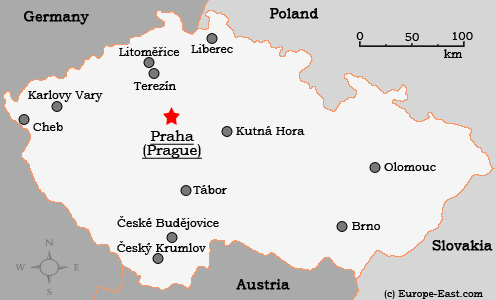Official name & Flag
Česká Republika (Czech republic). [ Č ] is pronounced [ch], hence the English form Czech (pronounced 'cheque'). The German name Tschechien is useful to know as well. The territory of the Czech Republic itself is also often referred to as the Czech lands.
The national flag is not new - it was already used as the national flag of Czechoslovakia between 1920 and 1992. White and red are the colours of Bohemia, blue is the flag of Moravia. Additionally, red, white and blue are the pan-Slavic colours and therefore also used in the national flags of Russia and Serbia.
Area & Population

| ||
| Clickable Map of the Czech Republic |
The Czech republic covers 78,886 km² only (appr. the same as South Carolina or Scotland) and is landlocked.
Around 10.2 million people live in the Czech Republic - with a clear downward tendency. As many other countries in middle and Eastern Europe, Czech struggles with the ongoing negative population growth rate due to the decline in the birthrate and the overaging of the society.
81% of the people are Czech (Bohemians), 13% Moravians (don't ask for the difference), 3% →Slovakians and smaller Polish, German (0.5%), Silesian, Gypsy, Hungarian and other minorities.¹
Religion
The ratio of religions is quite interesting - nearly 40% are Roman-Catholic, another 40% are non-religious. There are larger protestant and smaller orthodox minorities.¹
Time zone
As in middle Europe: GMT +01 hr, with daylight-saving time (+1 hour) in summer.
¹) Source: CIA World Factbook
Even before 1989, Czechoslovakia was one of the economically better situated countries in the communist East. This of course could be said about standard of living as well. During the political and economical upheavings at the beginning of the 1990ies, the Czech Republic experienced a sharp economical decline. However, Czech didn't suffer as much as most other countries of the Eastern bloc. The inflation could be stopped soon, and there's a sustainable growth of the economy and the GNP. Fiscal policy remains stable as well, which means that it soon fulfilled all criteria for a EU membership. And so the Czech Republic, among other countries such as →Hungary, →Poland and more, had been admitted to the European Union in spring 2004. The EU-membership had been approved by plebiscite, with around 75 % of the citizens voting for the membership. Eversince, esp. foreign and domestic trade as well as the purchasing power parity are growing substantially.
Neighbouring Germany remains the most important import and export partner, with a share of around 40% for both. Which is quite obvious - all bigger German chain stores, such as supermarkets and drugstores, can be found here as well. Sometimes the visitor must look twice to find out where he really is - in Germany or in the Czech Republic. Many companies were overtaken by German companies. The property market is dominated by German buyers. It will be interesting to see how the EU-membership is going to influence the domestic market.
Politically, the Czech republic is among the most stable countries of former East bloc nations. No coup d'états, no riots - instead of that, Vaclav Havel ruled the country for 10 years starting in 1993. Vaclav Havel earned much respect nationally and internationally. Thanks to him, the country could maintain resp. improve its good image throughout the world. In 2003, Havel retired. Soon after, Vaclav Klaus was succeeded as the nation's president.
But there is one international dispute remaining. The princely family of Liechtenstein lays claim to 1,600 km² of expropriated territory (10 times bigger then Liechtenstein!). According to various reliable sources, an annexation of the Czech republic by Liechtenstein's soldier(s) needn't be feared in the near future.
©2024 Europe-East.com

 Albania
Albania Czech Republic
Czech Republic